coolant level CHEVROLET BLAZER 1996 2.G Owners Manual
[x] Cancel search | Manufacturer: CHEVROLET, Model Year: 1996, Model line: BLAZER, Model: CHEVROLET BLAZER 1996 2.GPages: 392, PDF Size: 20.35 MB
Page 127 of 392
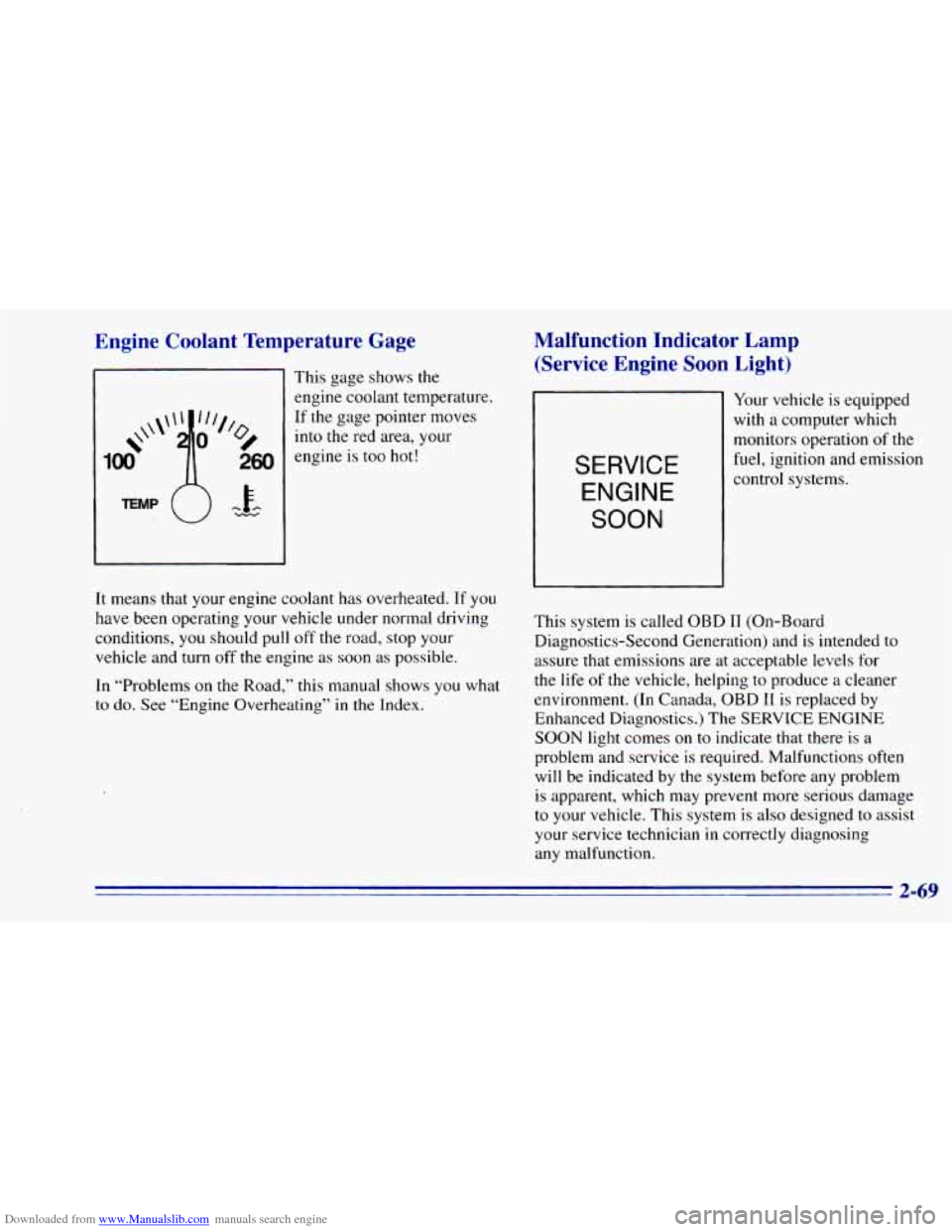
Downloaded from www.Manualslib.com manuals search engine Engine Coolant Temperature Gage
This gage shows the
engine coolant temperature.
If the gage pointer moves
into the red area, your
engine is too hot!
Malfunction Indicator Lamp
(Service Engine Soon Light)
SERVICE
ENGINE
SOON
Your vehicle is equipped
with a computer which
monitors operation
of the
fuel, ignition and emission
control systems.
It means that your engine coolant has overheated. If
you
have been operating your vehicle under normal driving
conditions,
you should pull off the road, stop your
vehicle and turn
off the engine as soon as possible.
In “Problems
on the Road,” this manual shows you what
to do. See “Engine Overheating” in the Index. This
system is called OBD I1 (On-Board
Diagnostics-Second Generation) and is intended to
assure that emissions are at acceptable levels for
the life
of the vehicle, helping to produce a cleaner
environment. (In Canada, OBD
I1 is replaced by
Enhanced Diagnostics.) The SERVICE ENGINE
SOON light comes on to indicate that there is a
problem and service is required. Malfunctions often
will be indicated by
the system before any problem
is apparent, which may prevent more serious damage
to your vehicle. This system is also designed to assist
your service technician
in correctly diagnosing
any malfunction.
2-69
Page 208 of 392
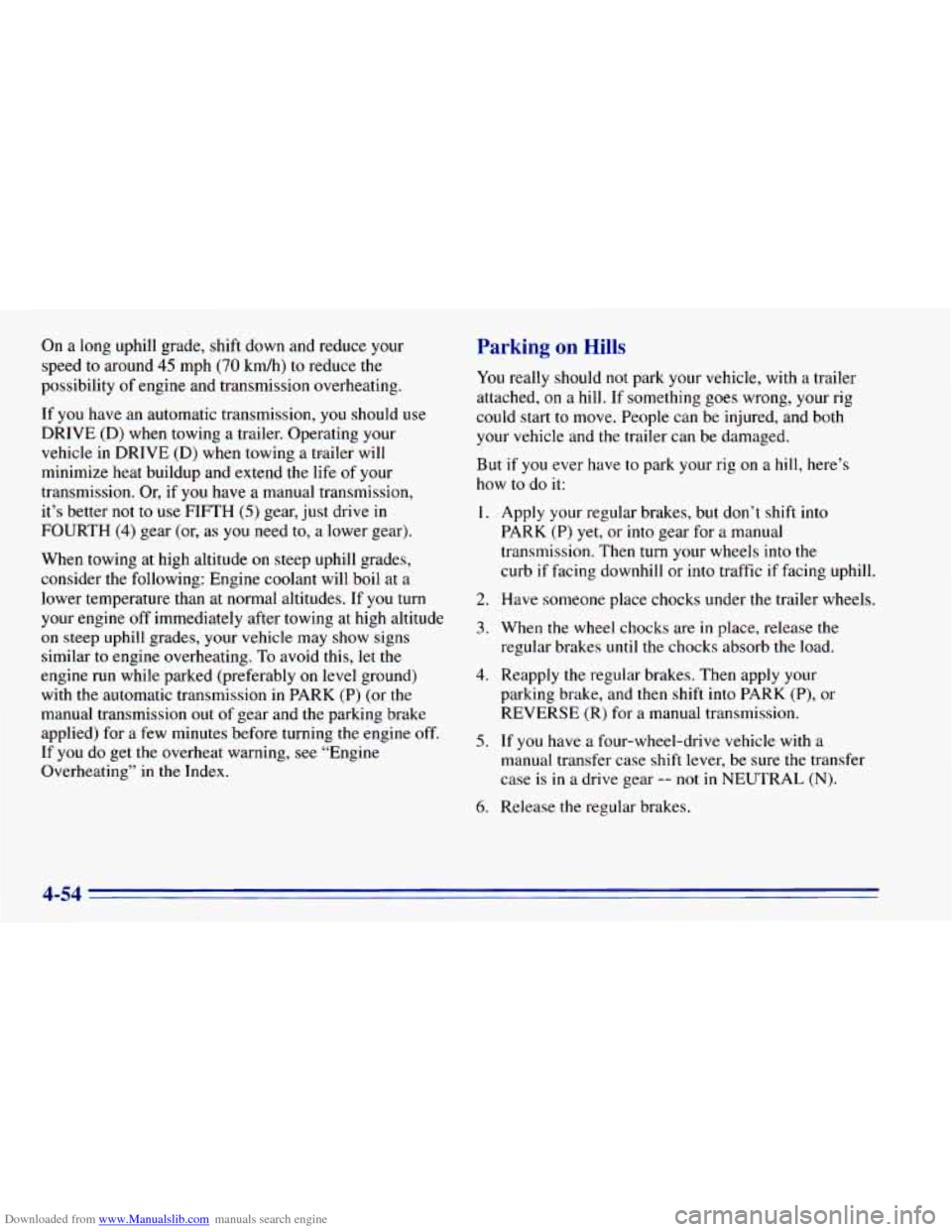
Downloaded from www.Manualslib.com manuals search engine On a long uphill grade, shift down and reduce your
speed to around
45 mph (70 kmh) to reduce the
possibility of engine and transmission overheating.
If you have
an automatic transmission, you should use
DRIVE (D) when towing
a trailer. Operating your
vehicle in DRIVE
(D) when towing a.trailer will
minimize heat buildup and extend the life of your
transmission. Or, if
you have a manual transmission,
it’s better not to use FIFTH
(5) gear, just drive in
FOURTH (4) gear (or, as you need to, a lower gear).
When towing at high altitude
on steep uphill grades,
consider the following: Engine coolant will boil at a
lower temperature than at normal altitudes. If you turn
your engine off immediately after towing at high altitude
on steep uphill grades, your vehicle may show signs
similar to engine overheating.
To avoid this, let the
engine run while parked (preferably on level ground)
with the automatic transmission in PARK
(P) (or the
manual transmission
out of gear and the parking brake
applied) for a few minutes before turning the engine off.
If
you do get the overheat warning, see “Engine
Overheating” in the Index.
Parking on Hills
You really should not park your vehicle, with a trailer
attached,
on a hill. If something goes wrong, your rig
could start to move. People can be injured, and both
your vehicle and the trailer can be damaged.
But
if you ever have to park your rig on a hill, here’s
how to
do it:
1.
2.
3.
4.
5.
6.
Apply your regular brakes, but don’t shift into
PARK
(P) yet, or into gear for a manual
transmission. Then turn your wheels into the
curb
if facing downhill or into traffic if facing uphill.
Have someone place chocks under the trailer wheels.
When the wheel chocks are
in place, release the
regular brakes
until the chocks absorb the load.
Reapply the regular brakes.
Then apply your
parking brake, and then shift into PARK (P), or
REVERSE
(R) for a manual transmission.
If
you have a four-wheel-drive vehicle with a
manual transfer case shift lever, be sure the transfer
case is
in a drive gear -- not in NEUTRAL (N).
Release the regular brakes.
4-54
Page 226 of 392
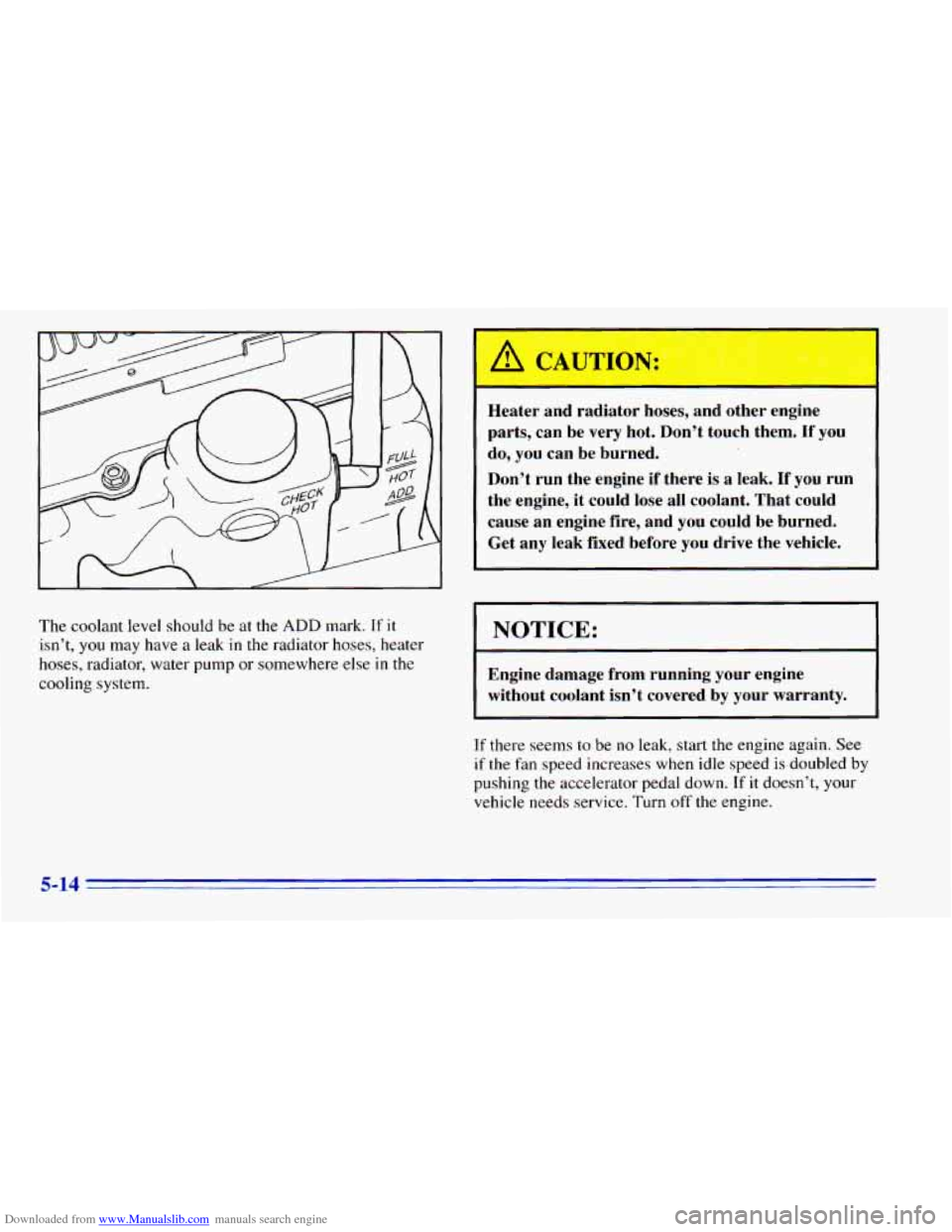
Downloaded from www.Manualslib.com manuals search engine L
The coolant level should be at the ADD mark. If it
isn't, you may have a leak in the radiator hoses, heater
hoses, radiator, water pump or somewhere else
in the
cooling system. Heater and radiator
hoses, and other engine
parts, can be very hot. Don't touch them. If you
do, you can be burned.
Don't run the engine if there is
a leak. If you run
the engine, it could lose all coolant, That could
cause an engine fire, and you could be burned.
Get any leak fixed before you drive the vehicle.
NOTICE:
Engine damage from running your engine
without coolant isn't covered by your warranty,
If there seems to be no leak, start the engine again. See
if
the fan speed increases when idle speed is doubled by
pushing the accelerator pedal down.
If it doesn't, your
vehicle needs service. Turn off the engine.
5-14
Page 227 of 392
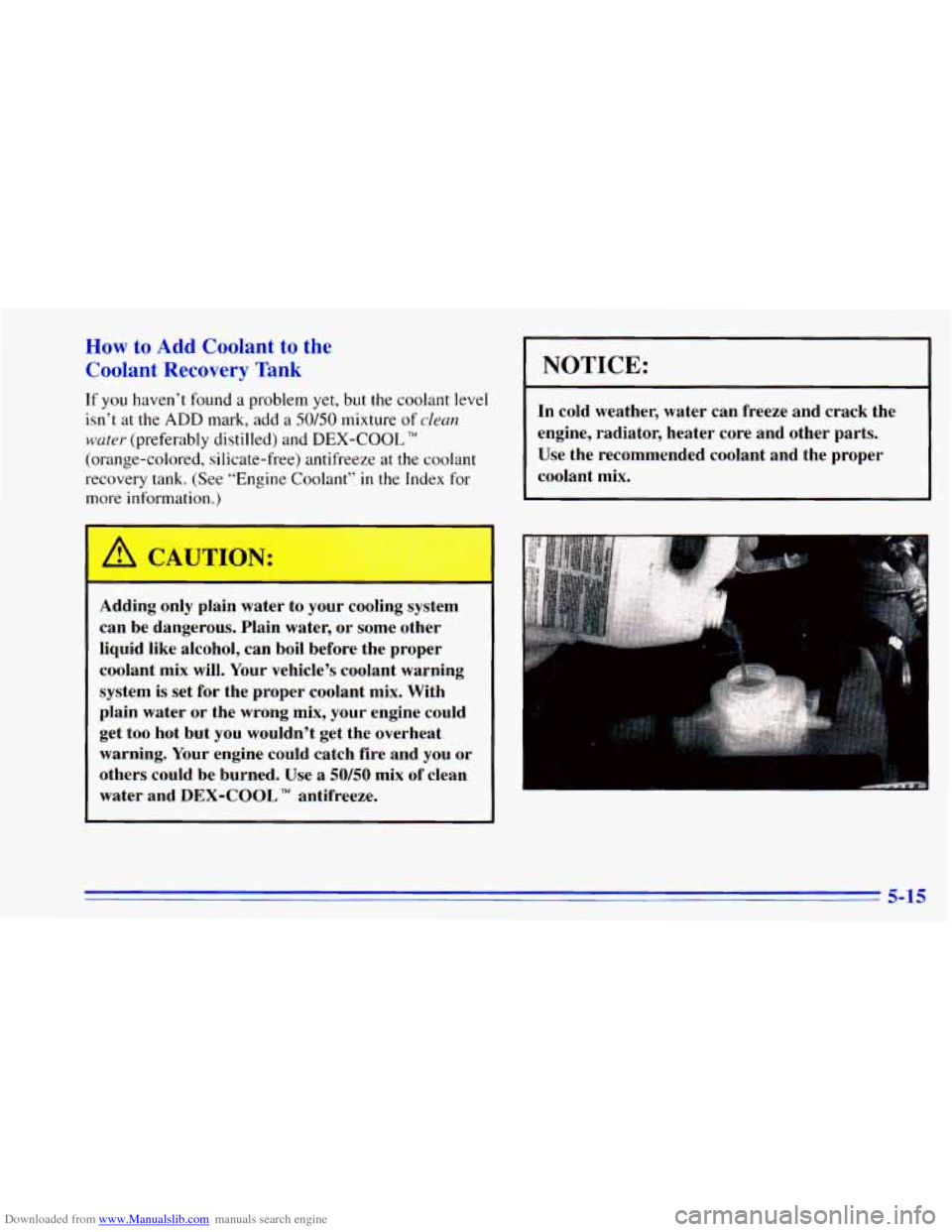
Downloaded from www.Manualslib.com manuals search engine How to Add Coolant to the
Coolant Recovery Tank
If you haven’t found a problem yet, but the coolant level
isn’t at the
ADD mark, add a 50/50 mixture of clean
water (preferably distilled) and DEX-COOL TM
(orange-colored, silicate-free) antifreeze at the coolant
recovery tank. (See “Engine Coolant”
in the Index for
more kformation
)
Adding only plain water to your cooling system
can be dangerous. Plain water, or some other
liquid like alcohol, can boil before the proper
coolant mix will. Your vehicle’s coolant warning
system is set for the proper coolant mix. With
plain water or the wrong mix, your engine could
get too hot but you wouldn’t get the overheat
warning. Your engine could catch fire and you or
others could be burned. Use
a 50/50 mix of clean
water and
DEX-COOL TM antifreeze.
1 NOTICE:
In cold weather, water can freeze and crack the
engine, radiator, heater core and other parts. Use the recommended coolant and the proper
coolant mix.
5-15
Page 231 of 392
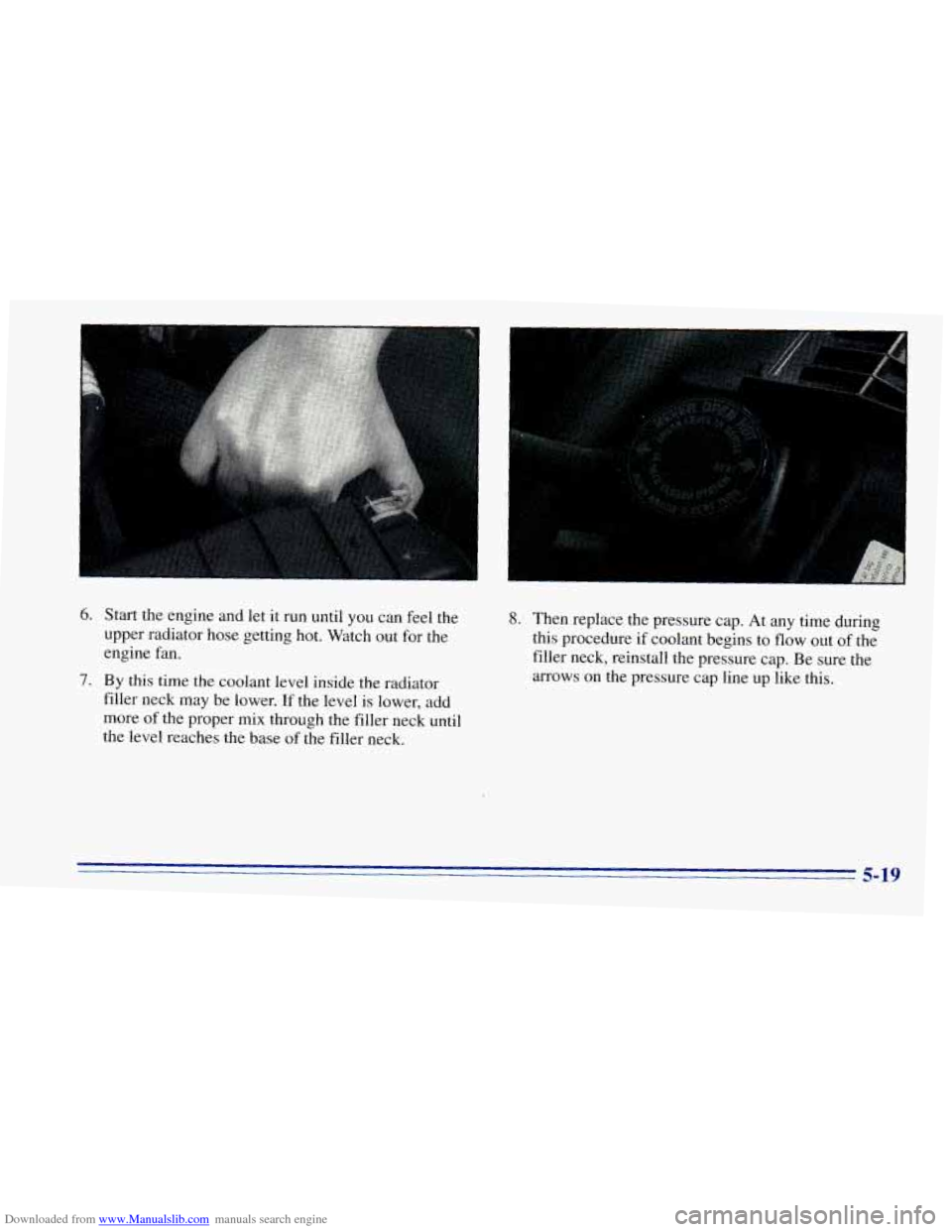
Downloaded from www.Manualslib.com manuals search engine 6. Start the engine and let it run until you can feel the
upper radiator hose getting hot. Watch out for the
engine fan.
filler neck may be lower.
If the level is lower, add
more
of the proper mix through the filler neck until
the level reaches the base of the filler neck.
7. By this time the coolant level inside the radiator
8.' Then replace the pressure cap. At any time during
this procedure
if coolant begins to flow out of the
filler neck, reinstall the pressure cap. Be sure the
arrows on the pressure cap line up like this.
, 5-19
Page 272 of 392
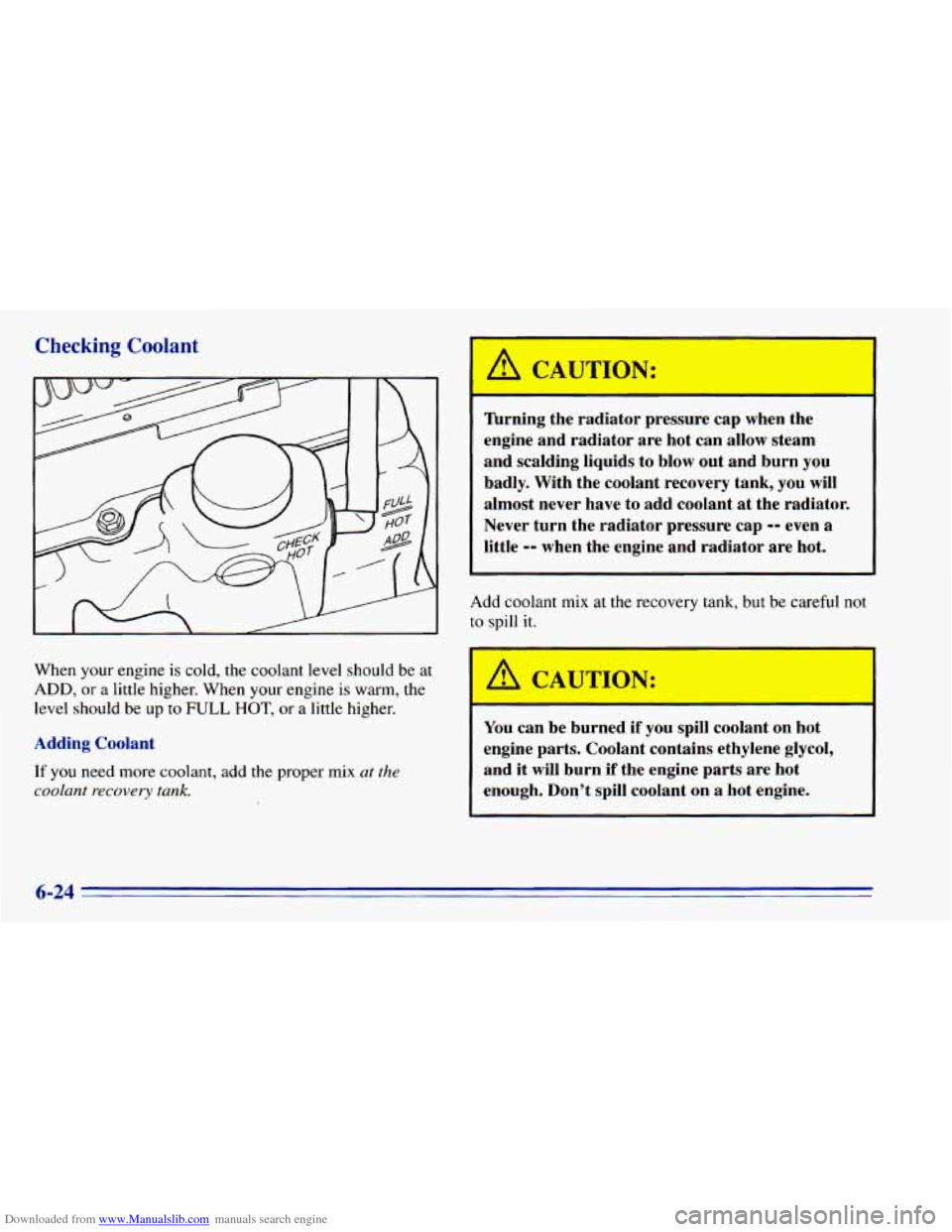
Downloaded from www.Manualslib.com manuals search engine Checking Coolant
When your engine is cold, the coolant level should be at
ADD, or a little higher. When your engine is warm, the
level should be up
to FULL HOT, or a little higher.
Adding Coolant
If you need more coolant, add
the proper mix at the
coolant
recovery tank.
A CAUTION:
I--
lbrning the radiator pressure cap when the
engine and radiator are hot can allow steam
and scalding liquids to blow out and burn you
badly. With the coolant recovery tank, you will
almost never have to add coolant at the radiator.
Never turn the radiator pressure cap
-- even a
little -- when the engine and radiator are hot.
Add coolant mix at the recovery tank, but be careful not
to spill it.
A CAUTION:
You can be burned if you spill coolant on hot
engine parts. Coolant contains ethylene glycol,
and it will
burn if the engine parts are hot
enough. Don’t spill coolant on a hot engine.
6-24
Page 357 of 392
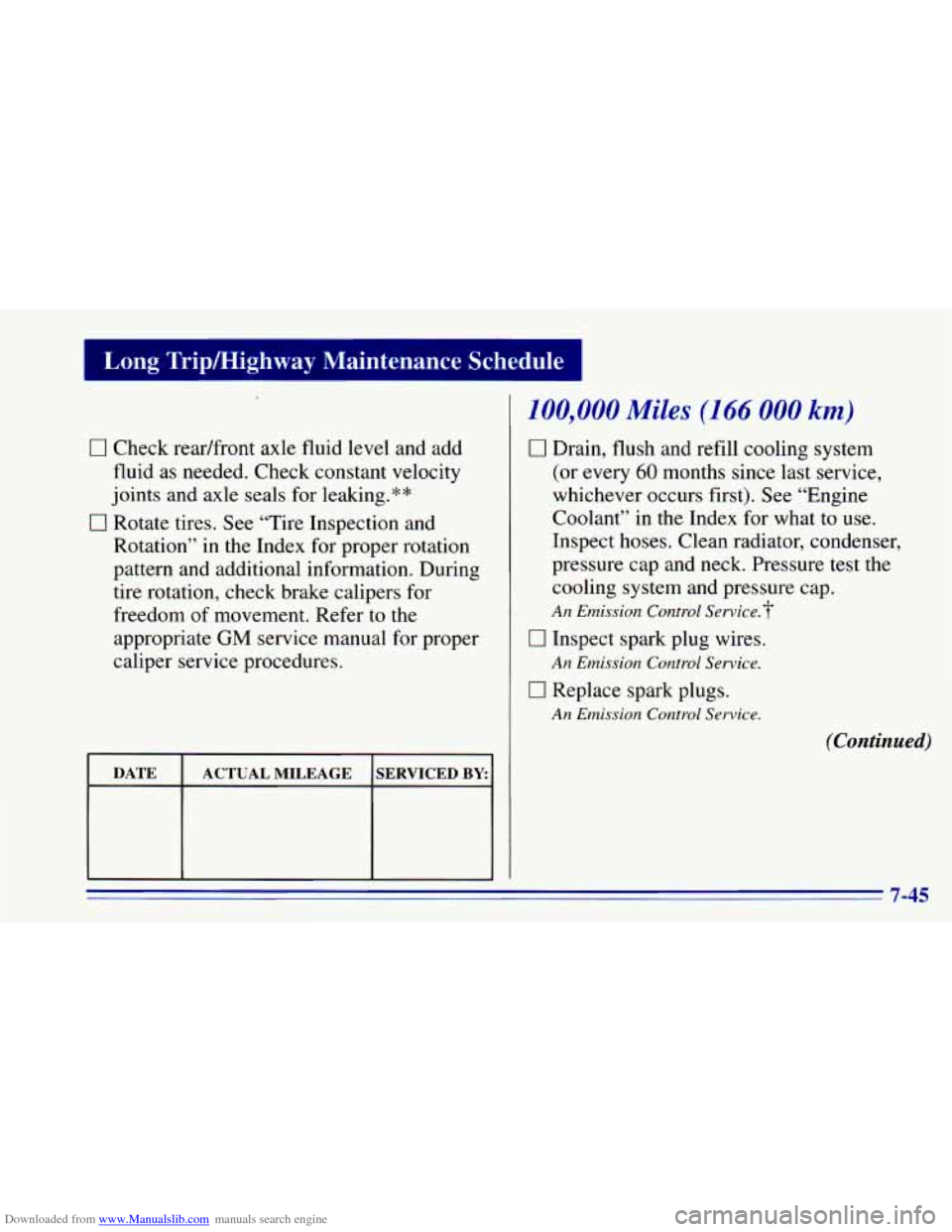
Downloaded from www.Manualslib.com manuals search engine I Long Tripmighway Maintenance Schedule I
0 Check readfront axle fluid level ana aaa
fluid as needed. Check constant velocity
joints and axle seals for leaking.**
0 Rotate tires. See “Tire Inspection and
Rotation” in the Index for proper rotation
pattern and additional information. During
tire rotation, check brake calipers for
freedom of movement. Refer
to the
appropriate
GM service manual for proper
caliper service procedures.
DATE ACTUAL MILEAGE SERVICED BY
100,000 Miles (1 66 000 km)
0 Drain, flush and refill cooling system
(or every
60 months since last service,
whichever occurs first). See “Engine
Coolant’’ in
the Index for what to use.
Inspect hoses. Clean radiator, condenser,
pressure cap and neck. Pressure test the
cooling system and pressure cap.
An Emission Control Service.
0 Inspect spark plug wires.
0 Replace spark plugs.
An Emission Control Service.
An Emission Control Service.
(Continued)
7-45
Page 359 of 392
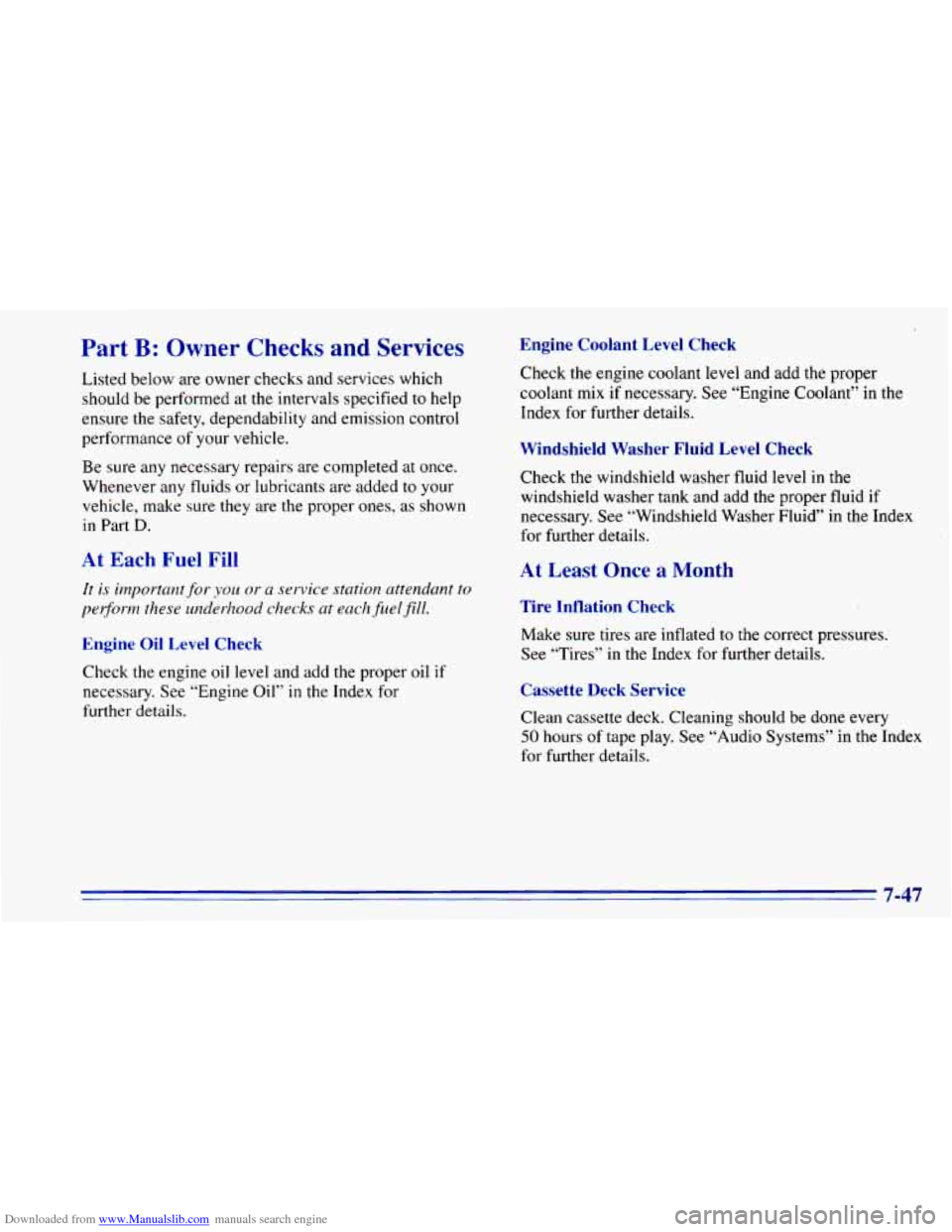
Downloaded from www.Manualslib.com manuals search engine Part B: Owner Checks and Services
Listed below are owner checks and services which
should be performed at the intervals specified to help
ensure the safety, dependability and emission control
performance of your vehicle.
Be sure any necessary repairs are completed at once.
Whenever any fluids or lubricants are added to your
vehicle, make sure they are the proper ones, as shown
in Part D.
At Each Fuel Fill
It is important for you or a service station attendant to
perform these underhood checks
at each fuel fill.
Engine Oil Level Check
Check the engine oil level and add the proper oil if
necessary. See “Engine Oil” in the Index for
further details.
Engine Coolant Level Check
Check the engine coolant level and add the proper
coolant mix if necessary. See “Engine Coolant” in the
Index for further details.
Windshield Washer Fluid Level Check
Check the windshield washer fluid level in the
windshield washer tank and add the proper fluid if
necessary. See “Windshield Washer Fluid” in the Index
for further details.
At Least Once a Month
Tire Inflation Check
Make sure tires are inflated to the correct pressures.
See “Tires”
in the Index for further details.
Cassette Deck Service
Clean ca :tte deck. Cleaning should be done every
50 hours or tape play. See “Audio Systems” in the Index
for further details.
7-47
Page 383 of 392
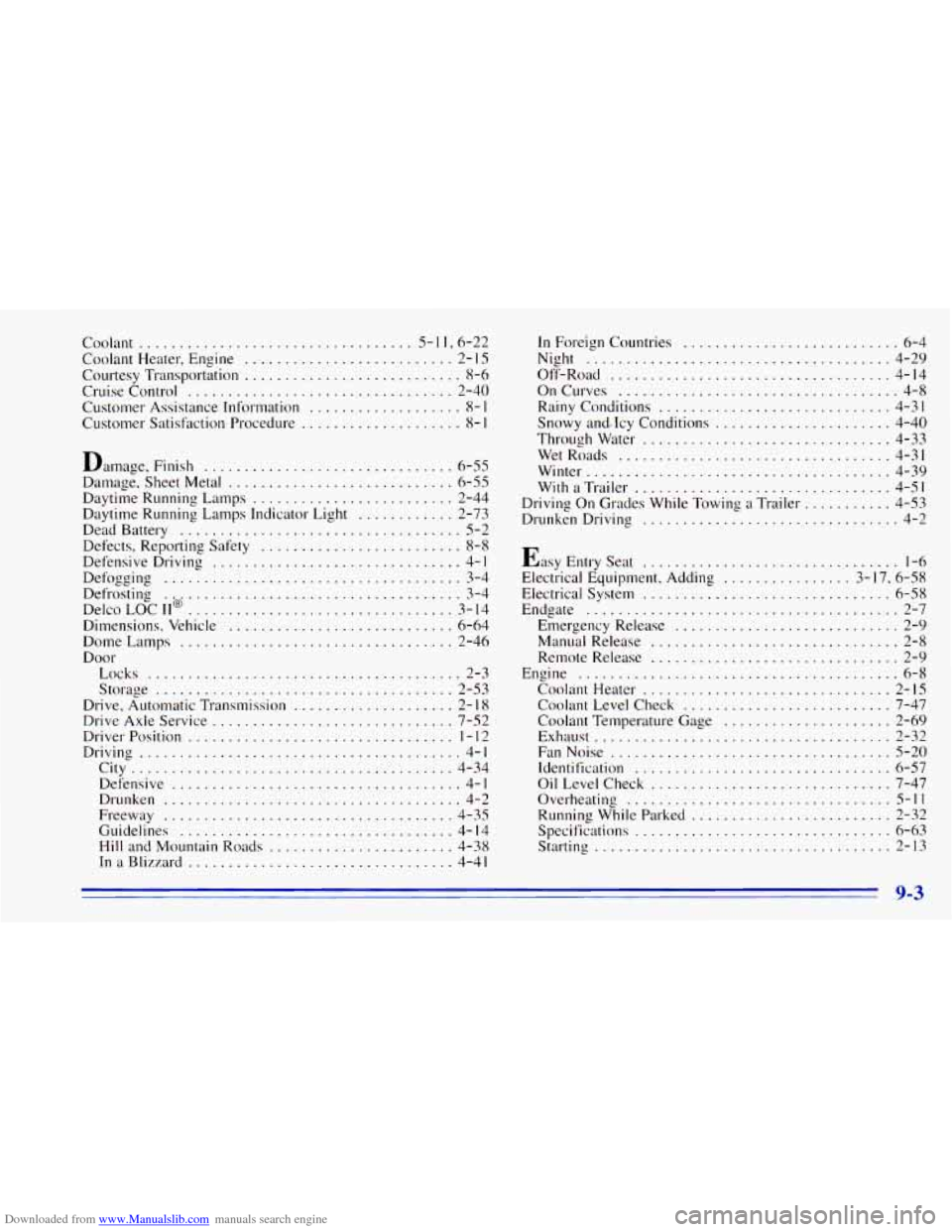
Downloaded from www.Manualslib.com manuals search engine Coolant .............................. 5- 1 1. 6-22
Courtesy Transportation
........................... 8-6
Cruise Control ................................. 2-40
Customer Assistance Information
................... 8- 1
Customer Satisfaction Procedure .................. 8- 1
Coolant Heater. Engine .......................... 2- I5
Damage. Finish ............................... 6-55
Damage. Sheet Metal
............................ 6-55
Daytime Running Lamps
......................... 2-44
Daytime Running Lamps Indicator Light
............ 2-73
Dead Battery
................................... 5-2
Defensive Driving
............................... 4- I
Defogging ..................................... 3-4
Defrosting
................................ 3-4
DelcoLOCII
................................. 3-14
Dimensions. Vehicle
............................ 6-64
Dome Lamps
............ .................. 2-46
Door Defects. Reporting Safety
......................... 8-8
@ **
Locks ....................................... 2-3
Storage
..................................... 2-53
Drive. Automatic Transmission
.................... 2- I8
Drive Axle Service .............................. 7-52
Driver Position
................................. I - 12
Driving ........................................ 4-1
City
........................................ 4-34
Defensive
.................................... 4-1
Drunken
..................................... 4-2
Freeway
.................................... 4-35
Guidelines
.................................. 4- I4
Hill and Mountain Roads ....................... 4-38
InaBlizzard
................................. 4-41
In Foreign Countries ........................... 6-4
Night
...................................... 4-29
Off-Road
................................... 4-14
OnCurves
................................... 4-8
Rainy Conditions
............................. 4-31
Snowy and. Icy Conditions
...................... 4-40
Throughwater
............................... 4-33
Wet Roads
.................................. 4-31
Winter
...................................... 4-39
With a Trailer
................................ 4-51
Driving On Grades While Towing a Trailer
........... 4-53
Drunken Driving
................................ 4-2
Easy Entry Seat
................................ 1-6
Electrical Equipment. Adding
................ 3- 17. 6-58
Electrical System
............................... 6-58
Endgate
....................................... 2-7
Emergency Release
............................ 2-9
ManualRelease
............................... 2-8
Remote Release ............................... 2-9
Coolant Heater
............................... 2-15
Coolant Level Check
.......................... 7-47
Coolant Temperature Gage
..................... 2-69
FanNoise
................................... 5-20
Identification
................................ 6-57
OilLevelCheck
.............................. 7-47
Overheating ................................. 5-11
Specifications ................................ 6-63
Engine
........................................ 6-8
Exllaust
..................................... 2-32
Running While Parked
......................... 2-32
Starting
..................................... 2-13
9-3